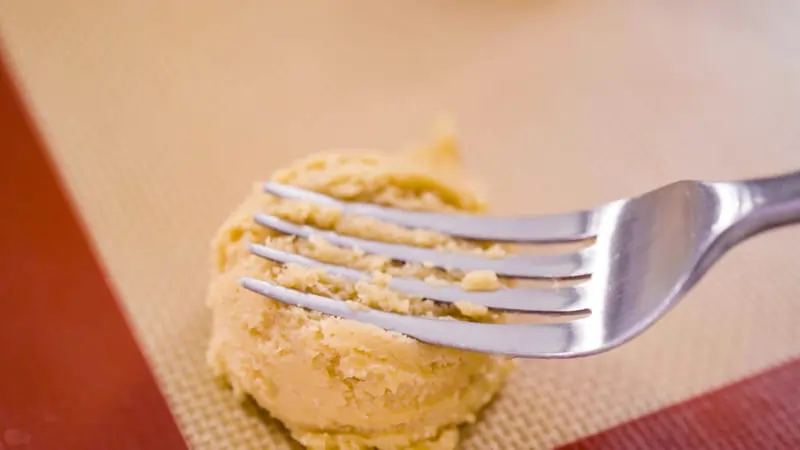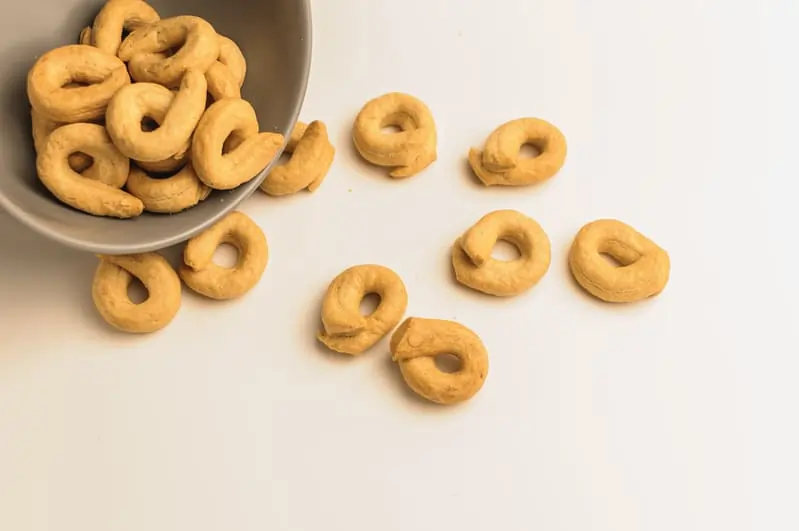Peanut butter cookies are a beloved classic, recognized instantly by their unique criss-cross fork marks. These cookies, with their rich, nutty flavor and soft yet slightly crumbly texture, are a favorite treat for many. But have you ever wondered why bakers put fork marks in peanut butter cookies? Let’s uncover the history, science, and modern variations behind this iconic baking tradition.
A Look at the History of Peanut Butter Cookies
The origins of peanut butter cookies trace back to the early 20th century when peanut butter became commercially available in the United States. Recipes for peanut butter cookies first appeared in cookbooks during the 1910s and 1920s, but the famous fork mark pattern wasn’t introduced until later.
In 1932, a recipe published by the Schauer Baking Company recommended pressing the cookies with a fork to flatten them, giving them their distinctive look. Flattening the dough served a practical purpose, but it also became an aesthetic hallmark of peanut butter cookies. Learn more about the history of cookie decorations and how tradition shapes modern baking.
Why Fork Marks Are Used in Peanut Butter Cookies
The iconic fork marks on peanut butter cookies serve both practical and aesthetic purposes. These simple criss-cross patterns have become a defining feature of this classic treat, offering more than just visual appeal. For additional tips on enhancing your cookies’ appearance, explore our creative patterns for cookies guide and learn how small details can make a big difference.
1. Practical Purpose: Even Baking
Peanut butter cookie dough is denser and oilier than most other types of cookie dough due to the high fat content in peanut butter. This unique texture poses a challenge when it comes to baking evenly.
- Why Fork Marks Help:
- Flattening the dough ensures the cookies spread properly and bake evenly, preventing the centers from being underbaked or the edges from overbaking.
- The criss-cross pattern also increases the surface area, allowing heat to penetrate the dough more effectively.
- How to Create Fork Marks:
- Use the back of a fork to press down on the cookie dough ball vertically, then horizontally, forming the signature criss-cross pattern.
- For consistent results, aim for a uniform thickness across all cookies.
Pro Tip: If you want softer cookies, avoid flattening the dough too much; a slight press is enough for even baking.
While the functional benefits of fork marks are essential, they also play a crucial role in enhancing the cookie’s appearance.
2. Aesthetic Appeal: The Iconic Criss-Cross Pattern
The fork marks are more than just functional—they’re a signature design that makes peanut butter cookies instantly recognizable.
- Why They Matter:
- The criss-cross pattern sets peanut butter cookies apart from other varieties, giving them a classic, homemade look.
- This simple decoration adds texture and visual interest, making the cookies more appealing on a plate or in packaging.
- Creative Variations:
- Dust the fork with sugar before pressing to add a subtle sparkle to the marks.
- Experiment with diagonal or wavy fork patterns for a modern twist.
Pro Tip: For holiday-themed peanut butter cookies, use a fork with decorative tines or press additional patterns with cookie stamps for a festive look.
Transition: Beyond fork marks, there are many ways to add flair to your peanut butter cookies and make them stand out.
Enhance Your Cookies with Small Details
If you’re looking to elevate the presentation of your peanut butter cookies, here are some ideas:
- Colorful Additions: Add sprinkles or drizzle melted chocolate over the criss-cross pattern for a pop of color. Check out our cookie decorating techniques for inspiration.
- Flavor Enhancements: Sprinkle flaky sea salt on top of the fork marks to balance the sweetness and create a gourmet touch.
- Custom Patterns: Use a fork with unique tines or other kitchen tools, like the back of a spoon, to experiment with alternative designs.
Why the Smallest Details Matter
Fork marks are more than a practical step in peanut butter cookie recipes—they’re a tradition that adds charm and character. By understanding their purpose and exploring creative variations, you can turn a simple cookie into something truly special. For more ideas on crafting visually stunning cookies, visit our creative patterns for cookies guide and start experimenting with new ways to leave your mark!
The Science Behind Fork Marks in Peanut Butter Cookies

Fork marks on peanut butter cookies are more than just a signature design—they play a critical role in the baking process. Understanding the science behind this simple step can help you achieve perfectly baked cookies every time. From texture control to even heat distribution, these marks are essential for ensuring your peanut butter cookies turn out soft, chewy, and visually appealing. For more insights into cookie science, explore our tips for creating soft and chewy cookies and enhance your baking skills.
1. Texture Control: Ensuring Uniform Thickness
Peanut butter cookie dough is denser and less pliable than most other cookie doughs due to the high fat content in peanut butter. Without flattening, the dough may remain uneven, leading to inconsistent textures in the final product.
- How Fork Marks Help:
- Flattening the dough ensures a uniform thickness across all cookies, allowing them to bake evenly.
- This prevents undercooked centers or over-crisp edges, resulting in a consistent, soft texture.
- Pro Tip: If you prefer slightly thicker cookies, press the dough gently with the fork to avoid over-flattening.
While texture control is crucial, the fork marks also address one of the unique challenges of peanut butter dough—its tendency to resist spreading.
2. Preventing Over-Spreading
Peanut butter dough is naturally dense and doesn’t spread as easily as other cookie doughs. This can result in overly thick cookies that bake unevenly if not addressed.
- How Fork Marks Help:
- Pressing the dough down encourages a more controlled spread during baking, ensuring the cookies maintain a desirable shape.
- Without this step, the cookies might bake unevenly, with the outside setting too quickly while the center remains dense.
- Pro Tip: For cookies that spread a bit more, you can increase the oven temperature slightly (by about 5°F) while using fork marks to maintain the criss-cross shape.
Beyond practical purposes, the fork marks also contribute to the cookie’s appearance, making them instantly recognizable.
3. Enhanced Aesthetic: Heat Distribution and Design
The grooves created by fork marks add more than just visual appeal—they also influence the way the cookies bake.
- How Fork Marks Help:
- The additional surface area created by the criss-cross pattern allows heat to penetrate the dough more evenly, reducing the risk of undercooked or overcooked spots.
- The pattern gives peanut butter cookies their iconic look, distinguishing them from other types of cookies and adding a nostalgic, homemade charm.
- Pro Tip: Dust the fork with granulated or brown sugar before pressing to add a subtle sparkle and prevent sticking.
By mastering the art of fork marks, you’re not just enhancing the look and feel of your cookies—you’re optimizing their overall quality.
Bonus Tips for Perfect Peanut Butter Cookies

- Experiment with Decorative Forks: Use forks with unique tines or designs to create custom patterns that add a personal touch.
- Combine Techniques: Press fork marks into cookies sprinkled with flaky sea salt, chocolate chips, or spices like cinnamon for a gourmet twist.
- Understand Dough Behavior: Learn how chilling peanut butter dough before shaping can make fork marks more defined and cookies easier to handle. Check out our baking tips for perfect cookies for more strategies.
Perfect Cookies Every Time
The fork marks in peanut butter cookies are a small but impactful step that balances texture, appearance, and baking efficiency. By flattening the dough, encouraging controlled spreading, and creating heat-friendly grooves, this technique ensures your cookies bake evenly and look amazing. For more advanced baking tips, explore our guide to creating soft and chewy cookies and take your cookie game to the next level!
Modern Takes on Fork Marks for Peanut Butter Cookies
The classic fork mark criss-cross pattern on peanut butter cookies is a beloved tradition, but modern bakers are taking this simple step to new creative heights. By experimenting with decorative stamps, global influences, and innovative designs, bakers are putting a fresh spin on this time-honored technique while preserving its functional benefits. For more inspiration on transforming traditional recipes, check out our simple and creative cookie ideas.
1. Decorative Stamps: Elevating Cookie Design
Instead of using a fork to press patterns into the dough, some bakers are opting for decorative stamps or cookie molds to create intricate and unique designs.
- Why It’s Popular:
- Stamps allow for detailed patterns, such as floral motifs, mandalas, or seasonal themes (e.g., snowflakes for winter or hearts for Valentine’s Day).
- They add a personalized, professional look to homemade cookies.
- How to Use Decorative Stamps:
- Lightly flour or sugar the stamp to prevent sticking, then press it firmly into the dough ball.
- For best results, use chilled dough to maintain the pattern during baking.
Pro Tip: Pair stamped designs with a dusting of powdered sugar or a drizzle of icing to highlight the patterns.
While decorative stamps add elegance, exploring how different cultures adapt peanut butter cookie designs can offer even more inspiration.
2. Global Variations: Cultural Twists on Peanut Butter Cookies
Around the world, bakers have embraced the practicality of flattening peanut butter cookie dough while incorporating local design traditions.
- Cultural Variations:
- In Japan, bakers might use cookie cutters to create moon-shaped or floral patterns, influenced by traditional wagashi designs.
- Scandinavian bakers often press intricate geometric patterns into cookies using wooden molds inspired by traditional butter stamps.
- Indian variations might incorporate patterns reminiscent of rangoli designs, paired with regional flavors like cardamom or jaggery.
Pro Tip: Incorporate regional spices or ingredients, like cinnamon, turmeric, or coconut, to complement the new design style.
Whether drawing inspiration from cultural traditions or personal creativity, modern designs take cookie customization to the next level.
3. Modern Designs: Spirals, Geometrics, and Themed Stamps
Contemporary bakers are pushing boundaries by experimenting with innovative patterns that elevate peanut butter cookies from simple treats to edible art.
- Popular Modern Designs:
- Spirals: Roll the dough into a cylinder, then slice and press a spiral pattern using a curved stamp or freehand tool.
- Geometric Patterns: Use small stamps or tools to create repeating triangles, squares, or hexagons for a modern aesthetic.
- Themed Stamps: Celebrate special occasions with stamps featuring holiday icons (like Christmas trees or Easter bunnies) or custom lettering for personal messages.
- How to Experiment:
- Try layering designs by first pressing a stamp into the dough and then adding subtle fork marks or hand-drawn accents.
- Incorporate colored dough or edible glitter to emphasize the modern patterns.
Pro Tip: For special occasions, coordinate the design with the flavor profile—for example, pair a snowflake pattern with a hint of peppermint or use a heart design with a touch of strawberry jam.
Whether you’re stamping, swirling, or keeping it classic, there are countless ways to add flair to your peanut butter cookies.
Bringing Creativity to Classic Recipes
Modern takes on fork marks show how a small, practical step can become an opportunity for creativity and customization. Whether you choose decorative stamps, cultural influences, or cutting-edge designs, each approach offers a chance to elevate peanut butter cookies into something truly special. For more unique ways to transform traditional recipes, explore our creative cookie ideas guide and start experimenting with your own inspired designs!
Storing and Serving Peanut Butter Cookies
Proper storage and thoughtful serving techniques can elevate your peanut butter cookies from a simple snack to a memorable treat. With the right approach, you can keep your cookies fresh and flavorful while ensuring they look their best when presented. Whether you’re baking ahead for an event or preparing a holiday spread, these tips will help you store and serve your cookies with care. For more baking insights, explore our tips for creating soft and chewy cookies.
1. Airtight Containers: The Key to Freshness
To maintain the rich flavor and tender texture of peanut butter cookies, storing them in an airtight container is essential.
- Why It Works:
- Airtight containers prevent air exposure, which can dry out the cookies or make them stale.
- They also help lock in the nutty aroma, preserving the cookies’ fresh-baked quality.
- How to Store:
- Place cookies in a single layer at the bottom of the container.
- For longer storage, consider dividing the cookies into smaller batches to minimize opening and closing the container.
Pro Tip: For extra softness, add a slice of bread or a wedge of apple to the container. These items release moisture, which helps keep the cookies tender.
Once your cookies are securely stored, layering them properly can prevent sticking or damage during storage.
2. Layer with Wax Paper: Protect the Shape
When storing multiple layers of cookies, it’s important to protect the iconic fork marks and prevent them from sticking together.
- Why It’s Important:
- The grooved surface of peanut butter cookies can easily stick to other cookies, especially in humid conditions.
- Wax paper acts as a barrier, preserving the criss-cross design and preventing breakage.
- How to Layer:
- Place a sheet of wax or parchment paper between each layer of cookies in the container.
- Ensure the layers are evenly spaced to avoid crushing the bottom layer.
Pro Tip: Use wax paper instead of plastic wrap, as it’s less likely to trap condensation, which can affect the cookies’ texture.
While proper storage ensures your cookies stay fresh, the fork marks also play a unique role in serving them.
3. Identify with Fork Marks: Simplify Serving
The iconic fork marks on peanut butter cookies aren’t just for decoration—they make it easy to identify them when serving an assortment of cookies.
- Why It’s Helpful:
- When offering a variety of baked goods, the criss-cross pattern serves as a clear identifier for guests with specific preferences or allergies.
- This is especially important for peanut butter cookies, as some people may have nut allergies.
- Serving Tips:
- Arrange cookies on a platter in rows or sections, grouping similar designs together for clarity.
- Add small labels or cards identifying each cookie type to make serving even easier.
Pro Tip: If you’re serving cookies at a party or event, consider decorating the fork marks with a drizzle of chocolate or a dusting of powdered sugar to make them stand out even more.
Beyond storage and serving, there are additional ways to ensure your peanut butter cookies remain fresh and flavorful for days.
Bonus Tips for Long-Term Storage
- Freeze for Later:
- If you’ve baked a large batch, freeze the cookies in a single layer on a baking sheet, then transfer them to a freezer-safe container or bag.
- Thaw at room temperature for a few hours before serving.
- Reheat for Freshness:
- To restore a just-baked texture, warm cookies in the microwave for 5–10 seconds before serving.
- Avoid Refrigeration:
- Storing cookies in the refrigerator can dry them out. Only refrigerate if your environment is particularly humid or if the cookies contain a perishable filling.
Pro Tip: When freezing cookies, use wax paper to separate layers to prevent them from sticking together during thawing.
FAQs
Why do peanut butter cookies need to be flattened?
Peanut butter dough is dense and doesn’t spread as much during baking. Flattening ensures even baking and proper texture. For additional tips on achieving the perfect texture, read about how to keep cookies soft and chewy.
What happens if I skip the fork marks?
Skipping fork marks can result in unevenly baked cookies with a less distinct texture. Learn more about how small changes impact cookie texture.
Can I use tools other than a fork for markings?
Yes! Many bakers use decorative tools or stamps for creative patterns. Discover more creative cookie designs and techniques.
Is the crosshatch pattern essential for taste?
No, but it’s crucial for texture and tradition, ensuring the cookies bake evenly. To explore other baking traditions, check out classic cookie recipes.
Why are peanut butter cookies denser than others?
The high fat and oil content in peanut butter make the dough denser, which contributes to their rich flavor. For ideas on balancing density and softness, explore quick and delicious peanut butter cookie recipes.
Conclusion
The fork marks in peanut butter cookies are more than just a decorative flourish—they serve a practical purpose, ensure even baking, and uphold a cherished tradition. From their historical roots to modern variations, these cookies remain a symbol of comfort and creativity in the kitchen. Whether you stick to the classic criss-cross or experiment with new designs, the next time you bake peanut butter cookies, you’ll know the secret behind their iconic look.

